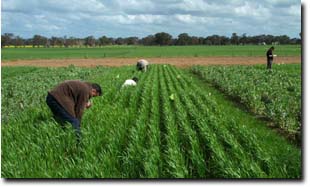SR1: Long-term agronomic & eco-sustainability of stubble management & tillage under crop rotations
|
Objectives
|  |
Key activities in current program
The current primary use of SR1 is to test the Carbon Manager OC Model in the measurement of changes in organic carbon for continuous cropping of grain legumes and cereal compared to the reversion to a short term pasture phase in the rotation, which includes canola (Table 2).
The data on organic carbon is also being used to refine modelling of soil carbon changes with the Rothamstead OC model and contribute to projects under the Inter-governmental Panel on Climate Change (IPCC) protocols. Selection processes imposed by stubble and rotation treatments could be assessed in the future on the basis of soil microbial changes, disease levels and soil fertility requirements could be measured in conjunction with productivity. Examination of causes for failure of canola establishment under stubble could be linked to CSIRO research on this topic. This site is being used as a reference site for green house gas studies.


